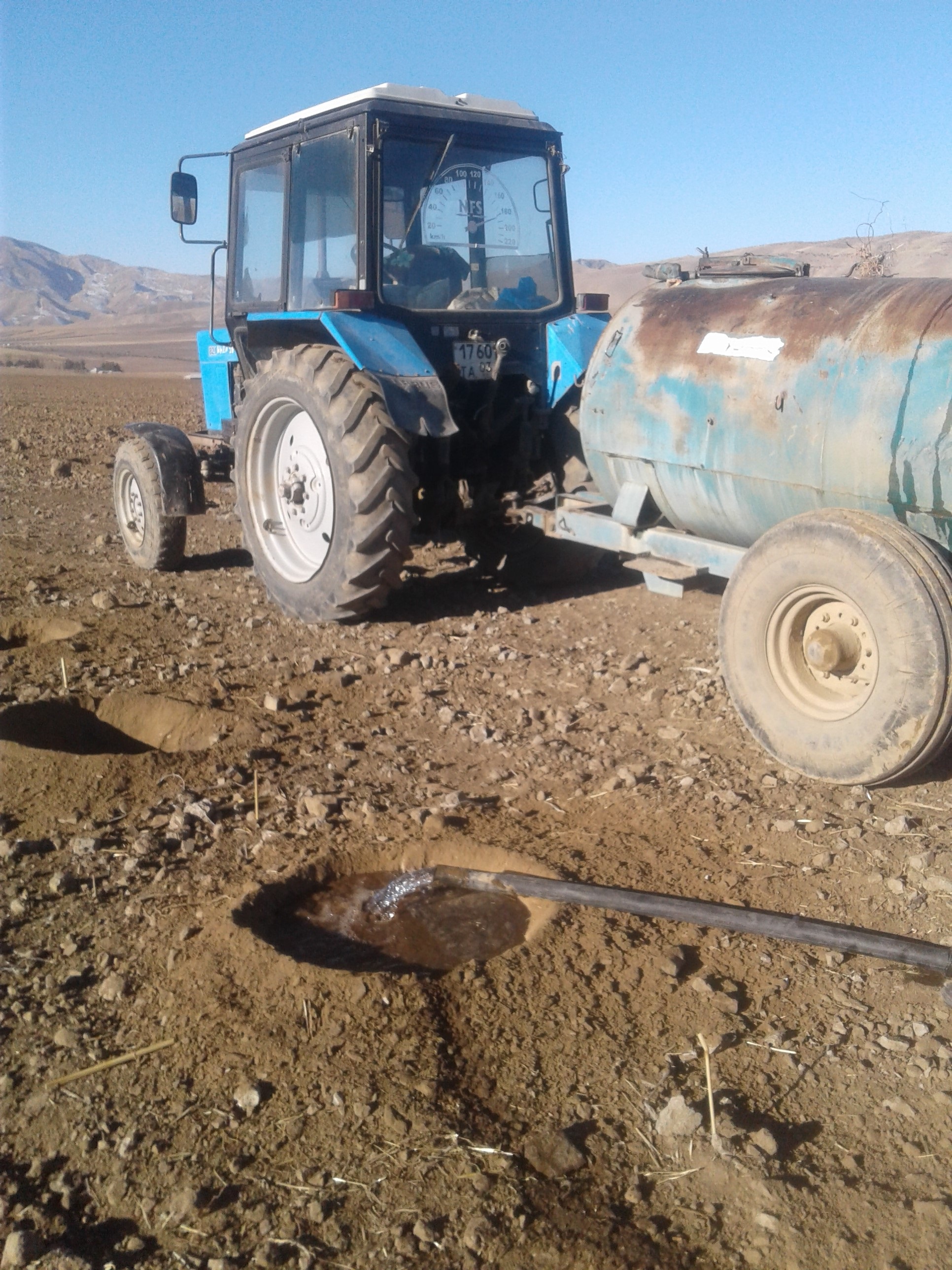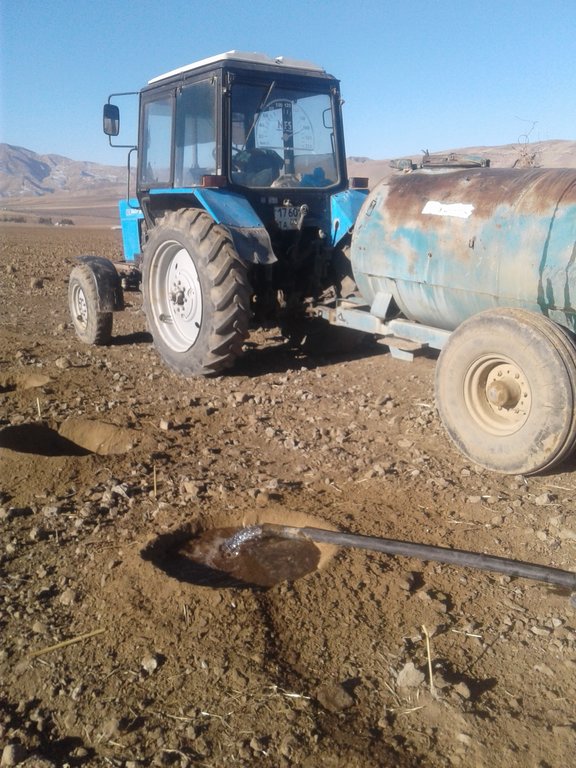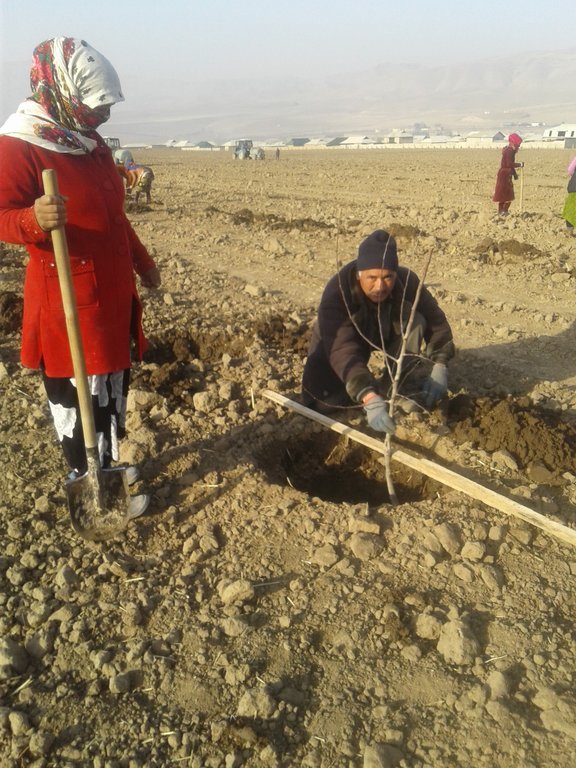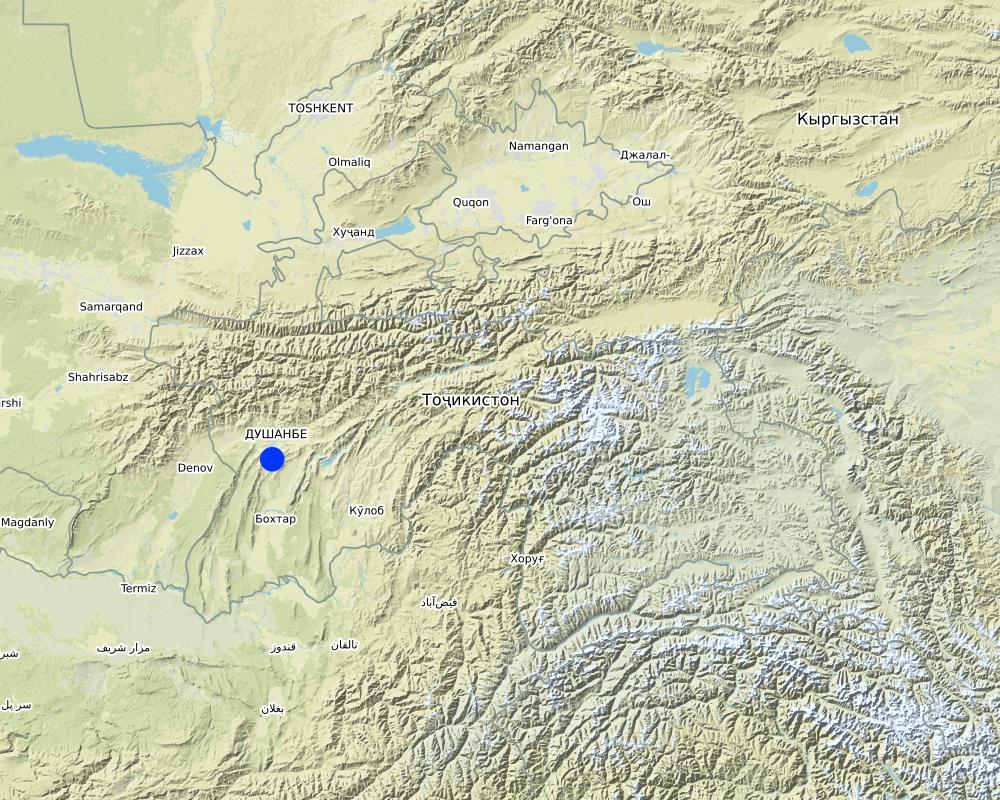Зимный полив для влагозарядки почвы перед посадкой садов и виноградников в условиясх засушливого зимы. [Tajikistan]
- Creation:
- Update:
- Compiler: Rustam Kalandarov
- Editor: –
- Reviewer: Farrukh Nazarmavloev
Усули захира кардани об пеш аз нихолшинони дар шароити замистони хушк.………………………………………………………………
technologies_3687 - Tajikistan
View sections
Expand all Collapse all1. General information
1.2 Contact details of resource persons and institutions involved in the assessment and documentation of the Technology
land user:
Рахимов Тагаймурод
93 552 30 30.
Фермерская хозяйства "Асадулло"
Хуросонский район. Хозяйства "Асадулло"
Tajikistan
Name of project which facilitated the documentation/ evaluation of the Technology (if relevant)
Environmental Land Management and Rural Livelihoods (ELMAR)Name of the institution(s) which facilitated the documentation/ evaluation of the Technology (if relevant)
Youth Ecological Center, Tajikistan (Youth Ecological Center, Tajikistan) - Tajikistan1.3 Conditions regarding the use of data documented through WOCAT
When were the data compiled (in the field)?
12/02/2018
The compiler and key resource person(s) accept the conditions regarding the use of data documented through WOCAT:
Yes
1.4 Declaration on sustainability of the described Technology
Is the Technology described here problematic with regard to land degradation, so that it cannot be declared a sustainable land management technology?
No
Comments:
Технология природосберегающий противо эрозионный влгонакапляющий система для выращивания садов и виноградников.
2. Description of the SLM Technology
2.1 Short description of the Technology
Definition of the Technology:
Технология заключается в том, что в некоторые годы зима очень засушливая. Для посадки саженцев почва не готова, по этому после разбивки участка надо копать лунки и заполнять их водой каждую. Через пару дней почва хорошо впитывает воду и уже можно сажать саженцев
2.2 Detailed description of the Technology
Description:
Эта технология в сравнение сплошным поливом на много экономит. Она применяется в дехканском хозяйстве Асадулло на площади боле 40 га. Природное условия в основном богарные, часть условно поливная зона. Часть земель на капельном орошение. Богарные зона здесь засушливая в основном влага есть за счет осадков которые выпадают осенью, зимой и весной. Годовая сумма осадков в последние годы не превышает 450 - 550 мм, это количество для богарного возделывания садов и виноградников недостаточное, считается необеспеченной багарой по этому при возможности проводят поливны. Бывают годы с очень малыми осадками, когда невозможно закладывать молодой сад. Были случай , когда в некоторые хозяйство богарной зоне отложили посадку нового сада из за засушливою периода на другой сезон года. Эта технология больше возможностей для посадки. Отличительные черты технологии в том, что в условиях засушливого (мало осадков) года её применяют в место сплошного полива (зимний полив) ,который раньше не пользовали во всех поливных зонах сельского хозяйства, но для этого необходимы постоянные поливные самотёчные каналы, чтобы поливать зимой. Однако, не всегда бывает такая возможность. По новой технологии можно обеспечить индивидуальный полив для каждой лунки где сажают саженец. После планировки участка на местах производят разбивку и копают лунки, причём копают специальным оборудованием для копки лунок. Каждая лунка глубиной 70-80 см. После выкопки лунки дополна заполняются водой почти по 80 л. Почва насыщается водой через пару днёй и лунка готова, в неё можно сажать саженцы. Основная цель накопление и обогащение почвы влагой, после которого саженцы хорошо приживаются. Обычный полив проводится типу «яхоба» но так как зимние поливы в последние годы из за ограничения электричества затруднены насосы не работают зимняя влагозарядки затруднена. Уже более 20 лет земледельцы «яхоба» не используют. Эта технология часто спасает садоводов в случае если зима проходит без осадков. После посадки во время вегетации можно продолжит обычный полив или капельное орошение в условиях поливного земледелия. Для запуска этой технологии необходимо только выкопать лунки и провести полив. Полив производится специальными тракторами с прицепленным специальным приспособлением поливной бочкой ОВТ, переоборудованной для полива. Во время полива работает один рабочий который держит шланг, если два шланга, то двое рабочих сразу два ряда лунок поливают. За один день можно поливать одним трактором почти 2 га площади сады.
Преимущество в том, что проводится экономный полив и 100% саженцев принимаются. Землепользователям этот способ подходит. Пользуются им те хозяйства, у которых есть возможность доставки горюче смазочных материалов и техники для завоза воды, водовозами для постоянно обеспечения водой поливных тракторов. При зимнем поливе (яхоб) это очень полезнее преимущество в том, что почва получает влагозарядку, уничтожаются зимующие вредители. Но однако в этих зонах вода подается с использованием электроэнергии, по поступление электроэнергии ограничено. Индивидуальный полив можно использовать даже в приусадебных участках.
2.3 Photos of the Technology
General remarks regarding photos:
На фотографии приведено лунки с политой воды , который подготовливается к просачиванию почвы и вдолнейшем посади саженцев.
2.5 Country/ region/ locations where the Technology has been applied and which are covered by this assessment
Country:
Tajikistan
Region/ State/ Province:
Хуросонский район. Хатлон
Further specification of location:
Фермерский хозяйства "Асадулло" уч. ка Фахрабад
Comments:
Технология находится на Юге в 35 км от столице. Предгорный холмистые зона.
Map
×2.6 Date of implementation
Indicate year of implementation:
2018
If precise year is not known, indicate approximate date:
- less than 10 years ago (recently)
2.7 Introduction of the Technology
Specify how the Technology was introduced:
- through land users' innovation
- during experiments/ research
Comments (type of project, etc.):
Технология является как инновация и научного эксперимента.
3. Classification of the SLM Technology
3.1 Main purpose(s) of the Technology
- improve production
- reduce, prevent, restore land degradation
- conserve ecosystem
- reduce risk of disasters
- adapt to climate change/ extremes and its impacts
- mitigate climate change and its impacts
3.2 Current land use type(s) where the Technology is applied

Cropland
- Tree and shrub cropping
Main crops (cash and food crops):
Основным сельскохозяйственным культурой является сады и виноградники.
Comments:
Тип землепользование является садоводства.
If land use has changed due to the implementation of the Technology, indicate land use before implementation of the Technology:
До применения тип землепользования было зернобобовые культуры.
3.3 Further information about land use
Water supply for the land on which the Technology is applied:
- mixed rainfed-irrigated
Comments:
Технологию используются в условно поливных землях.
Number of growing seasons per year:
- 1
Specify:
Урожай один раз за вегетацию.
3.4 SLM group to which the Technology belongs
- cross-slope measure
- irrigation management (incl. water supply, drainage)
3.5 Spread of the Technology
Specify the spread of the Technology:
- evenly spread over an area
If the Technology is evenly spread over an area, indicate approximate area covered:
- < 0.1 km2 (10 ha)
Comments:
Технология принимается пока в небольших участках не более 80 га.
3.6 SLM measures comprising the Technology

agronomic measures
- A1: Vegetation/ soil cover

vegetative measures
- V1: Tree and shrub cover
Comments:
Технология является агрономически с использованием растительности многолетних древесных и кустарниковых пород.
3.7 Main types of land degradation addressed by the Technology

soil erosion by water
- Wt: loss of topsoil/ surface erosion

water degradation
- Ha: aridification
3.8 Prevention, reduction, or restoration of land degradation
Specify the goal of the Technology with regard to land degradation:
- prevent land degradation
- reduce land degradation
Comments:
Для предотвращения деградации и эрозии почвы .
4. Technical specifications, implementation activities, inputs, and costs
4.1 Technical drawing of the Technology
4.2 Technical specifications/ explanations of technical drawing
На схеме приведено лунки и заполнены водой и посадка саженцы. Глубина лунки 60-70 см. заливают около70- 80 л воды. Влажность проникает до 150 см глубины почвы.
4.3 General information regarding the calculation of inputs and costs
Specify how costs and inputs were calculated:
- per Technology area
Indicate size and area unit:
на 1 га
If using a local area unit, indicate conversion factor to one hectare:
10000 метр квадрат
Specify currency used for cost calculations:
- US Dollars
Indicate exchange rate from USD to local currency (if relevant): 1 USD =:
8.9
Indicate average wage cost of hired labour per day:
3.0
4.4 Establishment activities
| Activity | Type of measure | Timing | |
|---|---|---|---|
| 1. | Разбивка участок по схеме посадки. | Agronomic | февраль. |
| 2. | Копать лунки | Agronomic | февраль |
| 3. | Заливка воды | Agronomic | февраль |
| 4. | Посадка саженцы. | Agronomic | февраль |
Comments:
Все работы проведено одновременно после покупки лунки сразу заливают водой и через 2 -3 дня можно сажать
4.5 Costs and inputs needed for establishment
| Specify input | Unit | Quantity | Costs per Unit | Total costs per input | % of costs borne by land users | |
|---|---|---|---|---|---|---|
| Labour | Механизированная работа копка лунки | день | 7.5 | 33.3 | 249.75 | 100.0 |
| Labour | Заливка воды. | день | 7.5 | 33.3 | 249.75 | 100.0 |
| Labour | посадка саженца | день | 100.0 | 0.4 | 40.0 | 100.0 |
| Other | 120.0 | |||||
| Total costs for establishment of the Technology | 539.5 | |||||
If land user bore less than 100% of costs, indicate who covered the remaining costs:
Затраты покриваются землепользователем.
Comments:
Частная хозяйства каждый землепользователь сами покрывают затраты.
4.7 Costs and inputs needed for maintenance/ recurrent activities (per year)
| Specify input | Unit | Quantity | Costs per Unit | Total costs per input | % of costs borne by land users | |
|---|---|---|---|---|---|---|
| Other | 120.0 |
If land user bore less than 100% of costs, indicate who covered the remaining costs:
Все затраты покрываются земле пользователем.
Comments:
Частная компания каждый землепользователь покрывает сам
4.8 Most important factors affecting the costs
Describe the most determinate factors affecting the costs:
Копка ям и заливка воды.
5. Natural and human environment
5.1 Climate
Annual rainfall
- < 250 mm
- 251-500 mm
- 501-750 mm
- 751-1,000 mm
- 1,001-1,500 mm
- 1,501-2,000 mm
- 2,001-3,000 mm
- 3,001-4,000 mm
- > 4,000 mm
Indicate the name of the reference meteorological station considered:
ГМС. г.Душанбе
Agro-climatic zone
- semi-arid
5.2 Topography
Slopes on average:
- flat (0-2%)
- gentle (3-5%)
- moderate (6-10%)
- rolling (11-15%)
- hilly (16-30%)
- steep (31-60%)
- very steep (>60%)
Landforms:
- plateau/plains
- ridges
- mountain slopes
- hill slopes
- footslopes
- valley floors
Altitudinal zone:
- 0-100 m a.s.l.
- 101-500 m a.s.l.
- 501-1,000 m a.s.l.
- 1,001-1,500 m a.s.l.
- 1,501-2,000 m a.s.l.
- 2,001-2,500 m a.s.l.
- 2,501-3,000 m a.s.l.
- 3,001-4,000 m a.s.l.
- > 4,000 m a.s.l.
Indicate if the Technology is specifically applied in:
- not relevant
Comments and further specifications on topography:
Технологию можно принимать не зависимо от рельефа .
5.3 Soils
Soil depth on average:
- very shallow (0-20 cm)
- shallow (21-50 cm)
- moderately deep (51-80 cm)
- deep (81-120 cm)
- very deep (> 120 cm)
Soil texture (topsoil):
- medium (loamy, silty)
Soil texture (> 20 cm below surface):
- medium (loamy, silty)
Topsoil organic matter:
- medium (1-3%)
If available, attach full soil description or specify the available information, e.g. soil type, soil PH/ acidity, Cation Exchange Capacity, nitrogen, salinity etc.
нет дангных
5.4 Water availability and quality
Ground water table:
> 50 m
Availability of surface water:
poor/ none
Is water salinity a problem?
No
Is flooding of the area occurring?
No
Comments and further specifications on water quality and quantity:
Зона является условно поливной или богара.
5.5 Biodiversity
Species diversity:
- medium
Habitat diversity:
- medium
Comments and further specifications on biodiversity:
биоразнообразия местности кустарники полукустарники трявянистые пологи встречаются мендалники Бояришники. и шиповники. Местобитания ландшафт откритого холмистого типа.
5.6 Characteristics of land users applying the Technology
Sedentary or nomadic:
- Sedentary
Market orientation of production system:
- subsistence (self-supply)
Off-farm income:
- less than 10% of all income
Relative level of wealth:
- rich
Individuals or groups:
- groups/ community
Level of mechanization:
- manual work
- animal traction
Gender:
- women
- men
Age of land users:
- youth
- middle-aged
Indicate other relevant characteristics of the land users:
Землепользователи постоянно жители местности работа ведется общиной иногда принимают наёмных рабочих сил.
5.7 Average area of land owned or leased by land users applying the Technology
- < 0.5 ha
- 0.5-1 ha
- 1-2 ha
- 2-5 ha
- 5-15 ha
- 15-50 ha
- 50-100 ha
- 100-500 ha
- 500-1,000 ha
- 1,000-10,000 ha
- > 10,000 ha
Is this considered small-, medium- or large-scale (referring to local context)?
- large-scale
Comments:
Хозяйства является крупным
5.8 Land ownership, land use rights, and water use rights
Land ownership:
- company
Land use rights:
- open access (unorganized)
Water use rights:
- open access (unorganized)
Comments:
Компания является частным.
5.9 Access to services and infrastructure
health:
- poor
- moderate
- good
education:
- poor
- moderate
- good
technical assistance:
- poor
- moderate
- good
employment (e.g. off-farm):
- poor
- moderate
- good
markets:
- poor
- moderate
- good
energy:
- poor
- moderate
- good
roads and transport:
- poor
- moderate
- good
drinking water and sanitation:
- poor
- moderate
- good
financial services:
- poor
- moderate
- good
6. Impacts and concluding statements
6.1 On-site impacts the Technology has shown
Socio-economic impacts
Production
crop production
Comments/ specify:
Производства увеличится после применения технологии
crop quality
Comments/ specify:
улучшится после применение технологии
6.2 Off-site impacts the Technology has shown
Comments regarding impact assessment:
Технология не влияет за приделами территориям не загрязняет не нарушает экологический баланс.
6.3 Exposure and sensitivity of the Technology to gradual climate change and climate-related extremes/ disasters (as perceived by land users)
Gradual climate change
Gradual climate change
| Season | Type of climatic change/ extreme | How does the Technology cope with it? | |
|---|---|---|---|
| annual temperature | increase | moderately | |
| seasonal temperature | winter | increase | well |
| annual rainfall | decrease | moderately | |
| seasonal rainfall | winter | decrease | moderately |
Climate-related extremes (disasters)
Meteorological disasters
| How does the Technology cope with it? | |
|---|---|
| local rainstorm | moderately |
| local hailstorm | moderately |
| local sandstorm/ duststorm | moderately |
Climatological disasters
| How does the Technology cope with it? | |
|---|---|
| heatwave | well |
| cold wave | well |
| extreme winter conditions | moderately |
| drought | moderately |
Comments:
Экстримальные явления для технологии не очень влияет кроме сильных жары и сильных морозов.
6.4 Cost-benefit analysis
How do the benefits compare with the establishment costs (from land users’ perspective)?
Short-term returns:
positive
Long-term returns:
positive
How do the benefits compare with the maintenance/ recurrent costs (from land users' perspective)?
Short-term returns:
positive
Long-term returns:
positive
Comments:
Эффективность затраты в краткосрочным и долгосрочным перспективы позитивное.
6.5 Adoption of the Technology
- 1-10%
If available, quantify (no. of households and/ or area covered):
домохозяйства это частная компания где принимается технология.
Of all those who have adopted the Technology, how many have did so spontaneously, i.e. without receiving any material incentives/ payments?
- 0-10%
Comments:
Технологию кто может те и принимают технологию без никаких доли.
6.6 Adaptation
Has the Technology been modified recently to adapt to changing conditions?
No
6.7 Strengths/ advantages/ opportunities of the Technology
| Strengths/ advantages/ opportunities in the land user’s view |
|---|
| Обеспечивается почва влагой, вырастут саженцы. |
| улучшает роз и развития |
| предотвращает засуху почвы. |
| Strengths/ advantages/ opportunities in the compiler’s or other key resource person’s view |
|---|
| Обеспечивается почва влагой, без потерии вырастут саженцы. |
| улучшает роз и развития |
| предотвращает засуху почвы. |
6.8 Weaknesses/ disadvantages/ risks of the Technology and ways of overcoming them
| Weaknesses/ disadvantages/ risks in the land user’s view | How can they be overcome? |
|---|---|
| Завоз воды. |
| Weaknesses/ disadvantages/ risks in the compiler’s or other key resource person’s view | How can they be overcome? |
|---|---|
| завоз воды и заполнят |
7. References and links
7.1 Methods/ sources of information
- field visits, field surveys
хозяйства
- interviews with land users
хозяйства
Links and modules
Expand all Collapse allLinks
No links
Modules
No modules







